Panasonic KX-TDA100D installation Guide
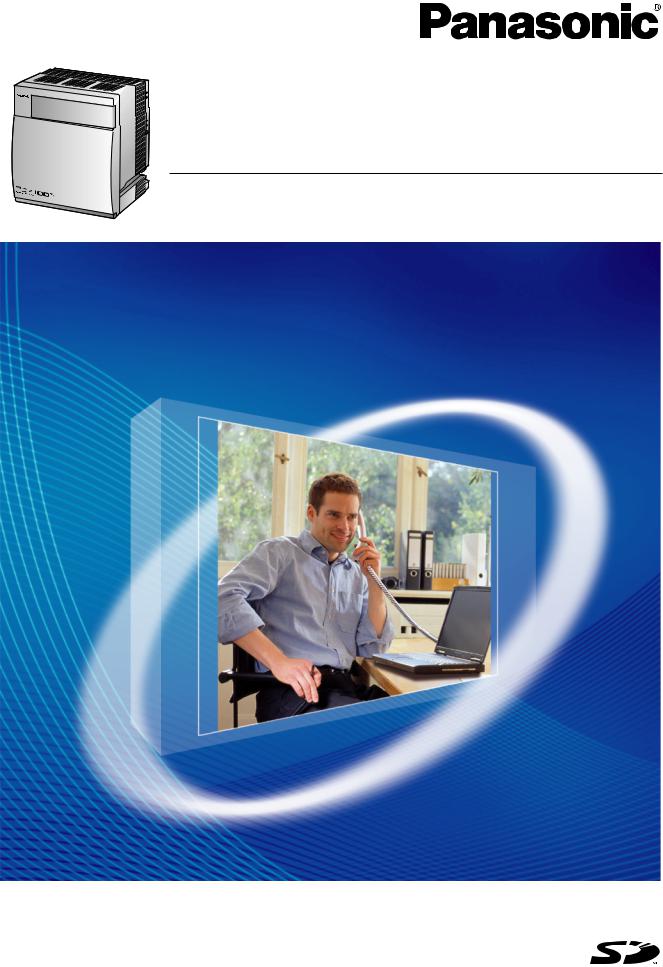
Installation Manual
Hybrid IP-PBX
Model No. KX-TDA100D
Thank you for purchasing a Panasonic Hybrid IP-PBX.
Please read this manual carefully before using this product and save this manual for future use.
KX-TDA100D: PDMPR Software File Version 5.1000 or later
SD Logo is
a trademark of SD-3C, LLC.

System Components
System Components
System Components Table
Category |
Model No. |
Description |
|
|
|
Shelf |
KX-TDA100D |
Basic Shelf |
|
|
|
Main Processing Card |
|
Main Processing Card (DMPR) |
|
|
|
DMPR Option Card |
KX-TDA0196 |
Remote Card (RMT) |
|
|
|
Trunk Cards |
KX-TDA0180 |
8-Port Analogue Trunk Card (LCOT8) |
|
KX-TDA0181 |
16-Port Analogue Trunk Card (LCOT16) |
|
KX-TDA0182 |
8-Port DID Card (DID8) |
|
KX-TDA0183 |
4-Port Analogue Trunk Card (LCOT4) |
|
KX-TDA0184 |
8-Port E & M Trunk Card (E&M8) |
|
KX-TDA0187 |
T-1 Trunk Card (T1) |
|
KX-TDA0188 |
E-1 Trunk Card (E1) |
|
KX-TDA0189 |
8-Port Caller ID/Pay Tone Card (CID/PAY8) |
|
KX-TDA0193 |
8-Port Caller ID Card (CID8) |
|
KX-TDA0284 |
4-Port BRI Card (BRI4) |
|
KX-TDA0288 |
8-Port BRI Card (BRI8) |
|
KX-TDA0290CE/ |
PRI Card (PRI30) |
|
CJ |
|
|
KX-TDA0290 |
PRI Card (PRI23) |
|
KX-TDA0484 |
4-Channel VoIP Gateway Card (IP-GW4E) |
|
KX-TDA0490 |
16-Channel VoIP Gateway Card (IP-GW16) |
|
KX-TDA1180 |
8-Port Analogue Trunk Card with CID (CLCOT8) |
|
KX-TDA1186 |
8-Port Analogue Trunk with Caller ID Daughter Card |
|
|
(CLCOT8E) |
|
|
|
Extension Cards |
KX-TDA0143 |
4 Cell Station Interface Card (CSIF4) |
|
KX-TDA0144 |
8 Cell Station Interface Card (CSIF8) |
|
KX-TDA0171 |
8-Port Digital Extension Card (DLC8) |
|
KX-TDA0172 |
16-Port Digital Extension Card (DLC16) |
|
KX-TDA0470 |
16-Channel VoIP Extension Card (IP-EXT16) |
|
KX-TDA1176 |
16-Port Single Line Telephone Extension with Caller |
|
|
ID and Message Lamp Card (MCSLC16) |
|
KX-TDA1178 |
24-Port Single Line Telephone Extension with Caller |
|
|
ID and Message Lamp Card (MCSLC24) |
|
|
|
2Installation Manual
|
|
|
|
System Components |
|
|
|
|
|
|
|
|
|
|
|
|
|
|
Category |
Model No. |
Description |
|
|
|
|
|
|
|
|
|
Other Cards |
KX-TDA0161 |
4-Port Doorphone Card (DPH4) |
|
|
|
|
|
KX-TDA0162 |
2-Port Doorphone Card (German Type) (DPH2) |
|
|
|
|
KX-TDA0164 |
4-Port External Input/Output Card (EIO4) |
|
|
|
|
KX-TDA0166 |
16-Channel Echo Canceller Card (ECHO16) |
|
|
|
|
KX-TDA0190 |
Optional 3-Slot Base Card (OPB3) |
|
|
|
|
KX-TDA0191 |
4-Channel Message Card (MSG4) |
|
|
|
|
KX-TDA0192 |
2-Channel Simplified Voice Message Card (ESVM2) |
|
|
|
|
KX-TDA0194 |
4-Channel Simplified Voice Message Card (ESVM4) |
|
|
|
|
KX-TDA0410 |
CTI Link Card (CTI-LINK) |
|
|
|
|
|
|
|
|
Optional SD Memory |
KX-TDA0920 |
SD Memory Card for Software Upgrade to Enhanced |
|
|
|
Card |
|
Version |
|
|
|
Cell Stations |
2.4 GHz |
KX-TDA0151CN |
2-Channel Cell Station Unit Using a DLC Card |
|
|
(CSs) |
|
|
(PT-interface CS) for 2.4 GHz Portable Station |
|
|
|
DECT |
KX-TDA0155CE |
2-Channel Cell Station Unit Using a DLC Card |
|
|
|
|
|
(PT-interface CS) for DECT Portable Station |
|
|
|
|
KX-TDA0156CE |
4-Channel Cell Station Unit Using a CSIF Card for |
|
|
|
|
|
DECT Portable Station |
|
|
|
|
KX-TDA0158CE |
8-Channel High-density Cell Station Unit Using a |
|
|
|
|
|
DLC Card (PT-interface CS) for DECT Portable |
|
|
|
|
|
Station |
|
|
|
|
|
|
|
|
Proprietary Equipment |
KX-A228 |
Back-up Battery Cable |
|
|
|
|
|
|
|
|
|
|
|
KX-A258 |
Blank Slot Cover |
|
|
|
|
|
|
|
|
|
|
KX-T30865 |
Doorphone |
|
|
|
|
KX-T7765 |
|
|
|
|
|
|
|
|
Equipment Compatibility
Compatible Panasonic Proprietary Telephones
The PBX supports the following telephones:
•Digital proprietary telephones (e.g., KX-DT300 series)
•IP proprietary telephones (e.g., KX-NT300 series)
•Portable stations (e.g., KX-TCA355, KX-TCA256)
•DSS consoles (e.g., KX-DT390)
•Single line telephones (e.g., KX-T7710)
Incompatible Panasonic Proprietary Telephones
The PBX does not support the following telephones:
•KX-T7400 series digital proprietary telephones
•KX-T7500 series digital proprietary telephones
•Analogue proprietary telephones (e.g., KX-T7700 series)
•KX-T30800 series proprietary telephones and DSS consoles
Installation Manual |
3 |
|
|

System Components
•KX-T61600 series proprietary telephones and DSS consoles
•KX-T123200 series proprietary telephones and DSS consoles
•KX-TD7500 DECT portable station
Note
•For the equipment (e.g., Add-on Key Module, USB Module, Headset) that can be connected to a particular telephone, refer to the telephone’s manual.
•For other equipment that can be connected to the PBX, refer to "1.1.2 System Connection Diagram".
Notice
•Under power failure conditions, the connected telephones may not operate. Please ensure that a separate telephone, not dependent on local power, is available for emergency use.
•Prior to connection of this product, please verify that the intended operating environment is supported. Satisfactory performance cannot be guaranteed for the following:
–interoperability and compatibility with all devices and systems connected to this product
–proper operation and compatibility with services provided by telecommunications companies over connected networks
Note
•Some optional hardware, software, and features are not available in some countries/areas. Please consult your certified Panasonic dealer for more information.
•In this manual, the suffix of each model number (e.g., KX-TDA100DCE) is omitted unless necessary.
Safety Notices
Please observe the safety notices in this manual in order to avoid danger to users or other people, and prevent damage to property.
The notices are classified as follows, according to the severity of injury or damage:
WARNING |
This notice means that misuse could result in death or serious injury. |
|
|
CAUTION |
This notice means that misuse could result in injury or damage to |
|
property. |
|
|
List of Abbreviations
•DPT ® Digital proprietary telephone
•IP-PT ® IP proprietary telephone
•PS ® Portable station
•PT ® Proprietary telephone
•SLT ® Single line telephone
4Installation Manual
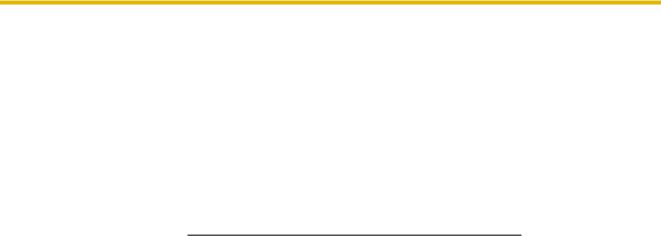
Important Safety Instructions
Important Safety Instructions
When using your telephone equipment, basic safety precautions should always be followed to reduce the risk of fire, electric shock and injury to persons, including the following:
•Do not use the product near water, for example, near a bathtub, wash bowl, kitchen sink, or laundry tub, in a wet basement, or near a swimming pool.
•Avoid using wired telephones during an electrical storm. There is a remote risk of electric shock from lightning.
•Do not use a telephone in the vicinity of a gas leak to report the leak.
SAVE THESE INSTRUCTIONS
Installation Manual |
5 |
|
|

Important Information
Important Information
SAVE THESE INSTRUCTIONS
WARNING
SAFETY REQUIREMENTS
For All Telephone Equipment
•Do not install the product in any other way than described in relevant manuals.
•The product must only be installed and serviced by qualified service personnel. The product should be used as-is from the time of purchase; it should not be disassembled or modified. Disassembly or modification can cause a fire, electric shock, or damage to the product.
•Do not install the product in a place exposed to rain or moisture, or a place where water, oil, or other liquids can drip or splash onto on the product. Such conditions can lead to fire or electric shock, and may impair the performance of the product.
•Follow all warnings and instructions marked on the product.
•Do not place the product on an unstable or uneven surface. If the product were to fall over, it may cause injury or damage to the product.
•Products that require a power source should only be connected to the type of electrical power supply specified on the product label. If you are not sure of the type of power supply to your home, consult your dealer or local power company.
•For safety purposes some products are equipped with an earthed plug. If you do not have an earthed outlet, please have one installed. Do not bypass this safety feature by tampering with the plug.
•Do not supply power to a combination of devices that exceeds the total rated capacity of the wall outlets or extension cables used. If outlets, power strips, extension cords, etc. are used in a manner that exceeds their rated capacity, they emit large amounts of heat, which could cause a fire.
•Unplug the product from the wall outlet and have it serviced by qualified service personnel in the following cases:
a.When the power supply cord or plug is damaged or frayed.
b.If liquid has been spilled into the product.
c.If the product has been exposed to rain or water.
d.If the product does not operate according to the operating instructions. Adjust only the controls that are explained in the operating instructions. Improper adjustment of other controls may result in damage and may require service by a qualified technician to restore the product to normal operation.
e.If the product has been dropped or the cabinet has been damaged.
f.If product performance deteriorates.
For the PBX
•If damage to the unit exposes any internal parts, disconnect the power supply cord immediately and return the unit to your dealer.
•To prevent fires, electric shock, injury, or damage to the product, be sure to follow these guidelines when performing any wiring or cabling:
a.Before performing any wiring or cabling, unplug the product’s power cord from the outlet. After completing all wiring and cabling, plug the power cord back into the outlet.
b.When laying cables, do not bundle the product’s power cord with the power cords of other devices.
c.Do not place any objects on top of the cables connected to the PBX.
d.When running cables along the floor, use protectors to prevent the cables from being stepped on.
e.Do not run any cables under carpeting.
6Installation Manual

Important Information
•Unplug this unit from the AC outlet if it emits smoke, an abnormal smell or makes unusual noise. These conditions can cause fire or electric shock. Confirm that smoke has stopped and contact an authorised Panasonic Factory Service Centre.
•Danger of explosion exists if a battery is incorrectly replaced. Replace only with the same or equivalent type recommended by the battery manufacturer. Dispose of used batteries according to the manufacturer’s instructions.
•Make sure that the wall that the shelf will be attached to is strong enough to support the shelf. If not, it is necessary for the wall to be reinforced.
•Only use the wall-mounting equipment (anchor plugs, screws, metal bracket) included with the PBX.
•Do not insert objects of any kind into this product, as they may touch dangerous voltage points or short out parts that could result in a fire or electric shock.
CAUTION
SAFETY REQUIREMENTS
For All Telephone Equipment
•The product should be kept free of dust, moisture, high temperature (more than 40 °C) and vibration, and should not be exposed to direct sunlight.
•Unplug the product from the wall outlet before cleaning. Wipe the product with a soft cloth. Do not clean with abrasive powders or with chemical agents such as benzene or thinner. Do not use liquid cleaners or aerosol cleaners.
For the PBX
•Before touching the product (PBX, cards, etc.), discharge static electricity by touching ground or wearing an earthing strap. Failure to do so may cause the PBX to malfunction due to static electricity.
•When driving the screws into the wall, be careful to avoid touching any metal laths, wire laths or metal plates in the wall.
•When relocating the equipment, first disconnect the telecom connection before disconnecting the power connection. When the unit is installed in the new location, reconnect the power first, and then reconnect the telecom connection.
•The power supply cord is used as the main disconnect device. Ensure that the AC outlet is located near the equipment and is easily accessible.
•The SD Memory Card poses a choking hazard. Keep the SD Memory Card out of reach of children.
•Slots and openings in the front, back and bottom of the cabinet are provided for ventilation; to protect it from overheating, these openings must not be blocked or covered. The openings should never be blocked by placing the product on a bed, sofa, rug, or other similar surface while in use. The product should never be placed near or over a radiator or other heat source. This product should not be placed in a sealed environment unless proper ventilation is provided.
•When this product is no longer in use, make sure to detach it from the wall.
SECURITY REQUIREMENTS
In order to use the PBX safely and correctly, the Security Requirements below must be observed. Failure to do so may result in:
•Loss, leakage, falsification or theft of user information.
•Illegal use of the PBX by a third party.
•Interference or suspension of service caused by a third party.
What is User Information?
User Information is defined as:
1. Information stored on the SD Memory Card
Installation Manual |
7 |
|
|

Important Information
Phonebook data, user IDs, system settings data, passwords (User/Administrator/Installer), Personal Identification Numbers (PINs), etc.
2.Information sent from the PBX to a PC or other external device:
Phone call data (including telephone numbers of outside parties), call charge data, etc.
Requirements
1.The SD Memory Card contains software for all the processes of the PBX and all customer data. It can be easily removed and taken away from the PBX by a third party. Therefore, do not allow unauthorised access to prevent data leakage.
2.Always make backups of data stored on the SD Memory Card. For details, refer to "2.6.2 Utility—File Transfer PC to PBX (SD Card)" and "2.6.3 Utility—File Transfer PBX (SD Card) to PC" in the PC Programming Manual.
3.To prevent illegal access from the Internet, activate a Firewall.
4.To avoid unauthorised access and possible abuse of the PBX, we strongly recommend:
a.Keeping the password secret.
b.Selecting a complex, random password that cannot be easily guessed.
c.Changing your password regularly.
5.Perform the following when sending the PBX for repair or handing it over to a third party.
a.Make a backup of data stored on the SD Memory Card.
b.Using an SD formatter, format the SD Memory Card so that information cannot be retrieved from it.
6.To prevent data leakage, render the SD Memory Card physically unusable before disposal.
7.When user information is sent from the PBX to a PC or other external device, the confidentiality of that information becomes the responsibility of the customer. Before disposing of the PC or other external device, ensure that data cannot be retrieved from it by formatting the hard disk and/or rendering it physically unusable.
Notice
SAFETY REQUIREMENTS
For All Telephone Equipment
•Read and understand all instructions.
For the PBX
•When placing the metal bracket, make sure that the "TOP" arrow is pointing upward.
•Keep the unit away from heating appliances and devices that generate electrical noise such as fluorescent lamps, motors and televisions. These noise sources can interfere with the performance of the PBX.
•If you are having problems making calls to outside destinations, follow this procedure to test the trunks:
a.Disconnect the PBX from all trunks.
b.Connect known working SLTs to those trunks.
c.Make a call to an external destination using those SLTs.
If a call cannot be carried out correctly, there may be a problem with the trunk that the SLT is connected to. Contact your telephone company.
If all SLTs operate properly, there may be a problem with your PBX. Do not reconnect the PBX to the trunks until it has been serviced by an authorised Panasonic Factory Service Centre.
8Installation Manual
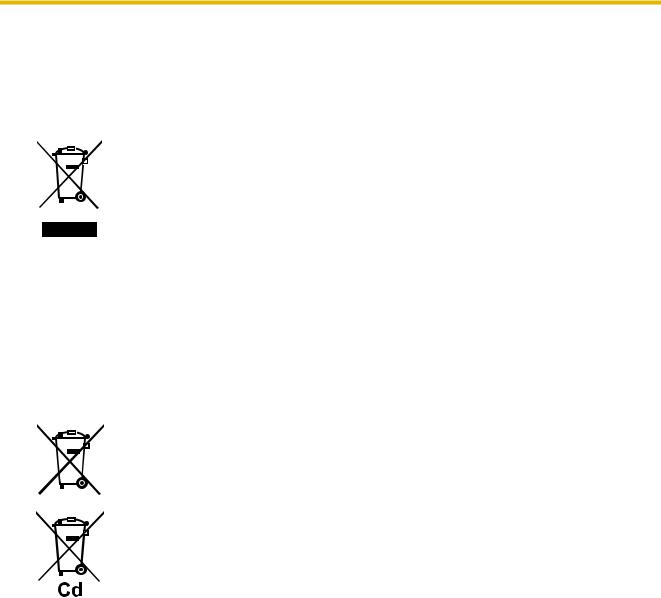
Precaution
Precaution
For users in the European Union only
Information for Users on Collection and Disposal of Old Equipment and used Batteries
These symbols on the products, packaging, and/or accompanying documents mean that used electrical and electronic products and batteries should not be mixed with general
household waste.
For proper treatment, recovery and recycling of old products and used batteries, please take them to applicable collection points, in accordance with your national legislation and the
Directives 2002/96/EC and 2006/66/EC.
By disposing of these products and batteries correctly, you will help to save valuable resources and prevent any potential negative effects on human health and the environment which could otherwise arise from inappropriate waste handling.
For more information about collection and recycling of old products and batteries, please contact your local municipality, your waste disposal service or the point of sale where you purchased the items.
Penalties may be applicable for incorrect disposal of this waste, in accordance with national legislation.
For business users in the European Union
If you wish to discard electrical and electronic equipment, please contact your dealer or supplier for further information.
Information on Disposal in other Countries outside the European Union
These symbols are only valid in the European Union. If you wish to discard these items, please contact your local authorities or dealer and ask for the correct method of disposal.
Note for the battery symbol (bottom two symbol examples):
This symbol might be used in combination with a chemical symbol. In this case it complies with the requirement set by the Directive for the chemical involved.
Installation Manual |
9 |
|
|

Introduction
Introduction
This Installation Manual is designed to serve as an overall technical reference for the Panasonic Hybrid IP-PBX, KX-TDA100D. It provides instructions for installing the hardware, and programming the PBX using the Maintenance Console.
The Structure of this Manual
This manual contains the following sections:
Section 1 System Outline
Provides general information on the PBX, including the system capacity and specifications.
Section 2 Installation
Describes the procedures to install the PBX. Detailed instructions for planning the installation site, installing the optional service cards, and cabling of peripheral equipment are provided. Further information on system expansion and peripheral equipment installation is included.
Section 3 Guide for the Maintenance Console
Explains the installation procedure, structure, and basic information of the Maintenance Console.
Section 4 Troubleshooting
Provides information on the PBX and telephone troubleshooting.
About the Other Manuals
Along with this Installation Manual, the following manuals are available:
Feature Guide
Describes all basic, optional and programmable features of the PBX.
PC Programming Manual
Provides step-by-step instructions for performing system programming using a PC.
PT Programming Manual
Provides step-by-step instructions for performing system programming using a PT.
User Manual
Provides operating instructions for end users using a PT, SLT, PS, or DSS Console.
About the software version of your PBX
The contents of this manual apply to PBXs with a certain software version, as indicated on the cover of this manual. To confirm the software version of your PBX, see "How do I confirm the software version of the PBX or installed cards?" in 2.7.1 Frequently Asked Questions (FAQ) of the PC Programming Manual, or "[190] Main Processing (MPR) Software Version Reference" in the PT Programming Manual.
Trademarks
•The Bluetooth® word mark and logos are owned by the Bluetooth SIG, Inc. and any use of such marks by Panasonic Corporation is under licence.
•Microsoft, Windows, and Windows Vista are either registered trademarks or trademarks of Microsoft Corporation in the United States and/or other countries.
•All other trademarks identified herein are the property of their respective owners.
•Microsoft product screen shot(s) reprinted with permission from Microsoft Corporation.
10 Installation Manual
|
|
|
Table of Contents |
|
|
||
Table of Contents |
|
||
1 |
System Outline ....................................................................................... |
13 |
|
1.1 |
|
Basic System Construction ........................................................................................... |
14 |
1.1.1 |
Basic Shelf ..................................................................................................................... |
14 |
|
1.1.2 |
System Connection Diagram .......................................................................................... |
15 |
|
1.2 |
|
Optional Equipment ........................................................................................................ |
17 |
1.2.1 |
Optional Equipment ........................................................................................................ |
17 |
|
1.3 |
|
Specifications .................................................................................................................. |
20 |
1.3.1 |
General Description ........................................................................................................ |
20 |
|
1.3.2 |
Characteristics ................................................................................................................ |
22 |
|
1.3.3 |
System Capacity ............................................................................................................ |
23 |
|
2 |
Installation .............................................................................................. |
29 |
|
2.1 |
|
Before Installation ........................................................................................................... |
30 |
2.1.1 |
Before Installation ........................................................................................................... |
30 |
|
2.2 |
|
Installation of the PBX .................................................................................................... |
32 |
2.2.1 |
Unpacking ...................................................................................................................... |
32 |
|
2.2.2 |
Names and Locations ..................................................................................................... |
33 |
|
2.2.3 |
Opening/Closing the Front Cover ................................................................................... |
35 |
|
2.2.4 |
Frame Earth Connection ................................................................................................ |
37 |
|
2.2.5 |
Backup Battery Connection ............................................................................................ |
38 |
|
2.2.6 |
Installing/Removing the Optional Service Cards ............................................................ |
40 |
|
2.2.7 |
Types of Connectors ...................................................................................................... |
45 |
|
2.2.8 |
Attaching a Ferrite Core ................................................................................................. |
47 |
|
2.2.9 |
Fastening Amphenol Connector ..................................................................................... |
51 |
|
2.2.10 |
Wall Mounting ................................................................................................................. |
53 |
|
2.2.11 |
Surge Protector Installation ............................................................................................ |
55 |
|
2.3 |
|
Information about the Main Processing Card .............................................................. |
58 |
2.3.1 |
DMPR Card .................................................................................................................... |
58 |
|
2.3.2 |
RMT Card (KX-TDA0196) .............................................................................................. |
60 |
|
2.4 |
|
Information about the Trunk Cards ............................................................................... |
61 |
2.4.1LCOT4 Card (KX-TDA0183), LCOT8 Card (KX-TDA0180), LCOT16 Card (KX-TDA0181),
|
and CLCOT8 Card (KX-TDA1180) ................................................................................. |
61 |
2.4.2 |
DID8 Card (KX-TDA0182) .............................................................................................. |
63 |
2.4.3 |
CID/PAY8 Card (KX-TDA0189) ...................................................................................... |
65 |
2.4.4 |
CID8 Card (KX-TDA0193) .............................................................................................. |
66 |
2.4.5 |
CLCOT8E Card (KX-TDA1186) ..................................................................................... |
67 |
2.4.6 |
E&M8 Card (KX-TDA0184) ............................................................................................ |
68 |
2.4.7 |
T1 Card (KX-TDA0187) .................................................................................................. |
70 |
2.4.8 |
E1 Card (KX-TDA0188) .................................................................................................. |
73 |
2.4.9 |
BRI4 Card (KX-TDA0284) and BRI8 Card (KX-TDA0288) ............................................. |
76 |
2.4.10 |
PRI30 Card (KX-TDA0290CE/KX-TDA0290CJ) ............................................................ |
80 |
2.4.11 |
PRI23 Card (KX-TDA0290) ............................................................................................ |
83 |
2.4.12 |
IP-GW4E Card (KX-TDA0484) ....................................................................................... |
86 |
2.4.13 |
IP-GW16 Card (KX-TDA0490) ....................................................................................... |
88 |
2.5 |
Information about the Extension Cards ........................................................................ |
90 |
2.5.1 |
CSIF4 Card (KX-TDA0143) and CSIF8 Card (KX-TDA0144) ........................................ |
90 |
2.5.2 |
DLC8 Card (KX-TDA0171) ............................................................................................. |
92 |
2.5.3 |
DLC16 Card (KX-TDA0172) ........................................................................................... |
94 |
2.5.4 |
MCSLC16 Card (KX-TDA1176) and MCSLC24 Card (KX-TDA1178) ........................... |
96 |
2.5.5 |
IP-EXT16 Card (KX-TDA0470) ...................................................................................... |
99 |
2.6 |
Information about the Other Cards ............................................................................. |
101 |
2.6.1 |
OPB3 Card (KX-TDA0190) .......................................................................................... |
101 |
Installation Manual |
11 |
|
|

Table of Contents
2.6.2 |
DPH4 Card (KX-TDA0161) .......................................................................................... |
102 |
2.6.3 |
DPH2 Card (KX-TDA0162) .......................................................................................... |
104 |
2.6.4 |
EIO4 Card (KX-TDA0164) ............................................................................................ |
107 |
2.6.5 |
ECHO16 Card (KX-TDA0166) ...................................................................................... |
110 |
2.6.6 |
MSG4 Card (KX-TDA0191) .......................................................................................... |
111 |
2.6.7 |
ESVM2 Card (KX-TDA0192) and ESVM4 Card (KX-TDA0194) .................................. |
112 |
2.6.8 |
CTI-LINK Card (KX-TDA0410) ..................................................................................... |
113 |
2.7 |
Connection of Extensions ............................................................................................ |
115 |
2.7.1 |
Maximum Cabling Distances of the Extension Wiring (Twisted Cable) ........................ |
115 |
2.7.2 |
Digital EXtra Device Port (Digital XDP) Connection ..................................................... |
117 |
2.7.3 |
First Party Call Control CTI Connection ....................................................................... |
119 |
2.8Connection of Doorphones, Door Openers, External Sensors, and External
Relays |
.............................................................................................................................120 |
2.8.1Connection of Doorphones, Door Openers, External Sensors, and External
|
Relays .......................................................................................................................... |
120 |
2.9 |
Connection of Peripherals ........................................................................................... |
123 |
2.9.1 |
Connection of Peripherals ............................................................................................ |
123 |
2.10 |
Power Failure Connections .......................................................................................... |
128 |
2.10.1 |
Power Failure Connections .......................................................................................... |
128 |
2.11 |
Starting the PBX ............................................................................................................ |
132 |
2.11.1 |
Starting the PBX ........................................................................................................... |
132 |
3 Guide for the Maintenance Console ................................................... |
135 |
|
3.1 |
Overview ........................................................................................................................ |
136 |
3.1.1 |
Overview ...................................................................................................................... |
136 |
3.2 |
PC Connection .............................................................................................................. |
137 |
3.2.1 |
PC Connection ............................................................................................................. |
137 |
3.3 |
Installation of the Maintenance Console .................................................................... |
139 |
3.3.1 |
Installing and Starting the Maintenance Console ......................................................... |
139 |
4 Troubleshooting ................................................................................... |
143 |
|
4.1 |
Troubleshooting ............................................................................................................ |
144 |
4.1.1 |
Installation .................................................................................................................... |
144 |
4.1.2 |
Connection ................................................................................................................... |
145 |
4.1.3 |
Operation ...................................................................................................................... |
147 |
4.1.4 |
Using the Reset Button ................................................................................................ |
148 |
4.1.5 |
Troubleshooting by Error Log ....................................................................................... |
149 |
Index |
............................................................................................................ |
151 |
12 Installation Manual

Section 1
System Outline
This section provides general information on the PBX, including the system capacity and specifications.
Installation Manual |
13 |
|
|
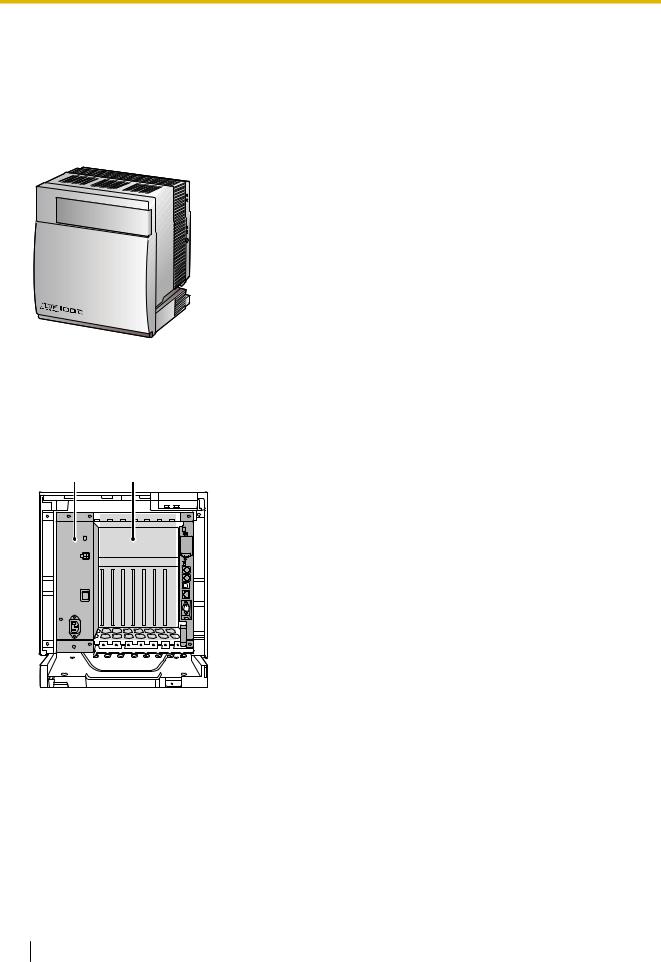
1.1.1 Basic Shelf
1.1 Basic System Construction
1.1.1 Basic Shelf
The basic shelf contains a power supply unit (PSU) and a DMPR card for starting and controlling the PBX. To use the system, install optional service cards in the basic shelf.
Construction of the Basic Shelf
A.PSU
B.Slots for Expansion
C.DMPR Card
A B
 C
C
14 Installation Manual

|
|
|
1.1.2 System Connection Diagram |
|
1.1.2 System Connection Diagram |
|
|
||
|
|
|
Private |
|
|
|
|
IP Network |
|
Trunk (Telephone Company Lines) |
|
|
|
|
Analogue/BRI/PRI/T1/E1 |
|
|
|
|
|
Remote PC |
|
|
|
|
|
PBX |
Router |
|
|
|
|
|
|
|
|
|
PC |
|
Batteries |
|
|
|
|
|
|
|
IP-PT |
|
|
SLT |
SLT |
|
|
|
|
|
IP Softphone |
|
PC |
|
|
|
|
|
Fax Machine |
|
|
|
|
|
DPT |
CTI Server |
|
|
|
|
|
|
Printer |
|
|
|
|
|
Wireless Phone |
PC |
|
|
|
DSS Console |
|
||
|
|
DPT |
|
|
External Sensor/ |
|
|
|
|
External Relay Device |
|
USB |
|
|
|
ISDN Telephone |
|
||
|
PC |
|
||
|
|
|
|
|
Doorphone & Door Opener |
KX-T7636/ |
PC |
|
|
KX-T7633 |
|
|
||
|
|
|
|
|
|
PS |
CS |
USB |
|
|
|
|
|
|
BGM/Music On Hold (MOH) |
|
|
|
|
|
|
KX-DT346/ |
PC |
|
|
|
KX-DT343 |
|
|
Pager/ |
Amplifier |
|
|
|
Speaker |
Voice Processing |
|
|
|
|
|
|
||
|
System |
|
|
|
|
|
KX-T7600 |
KX-T7600 |
|
|
|
KX-DT300 |
KX-DT300 |
|
|
|
|
Installation Manual |
15 |
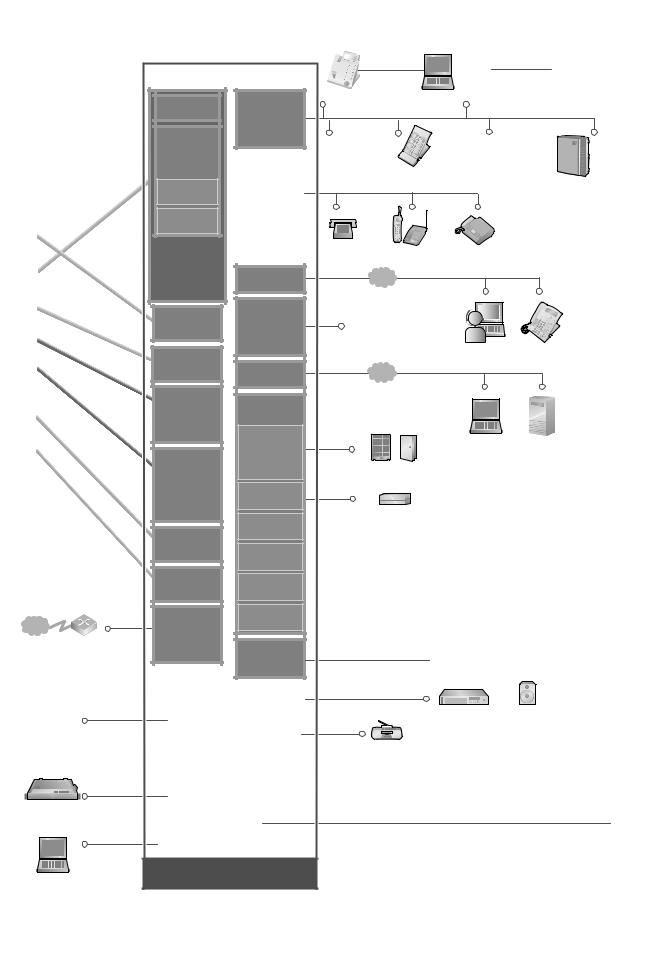
1.1.2 System Connection Diagram
|
|
LCOT4 |
DLC16 |
|
|
|
(KX-TDA0183) |
(KX-TDA0172) |
|
|
|
LCOT16 |
DLC8 |
|
|
|
(KX-TDA0171) |
||
|
|
(KXLCOT16-TDA0181) |
||
|
|
|
||
|
|
(KX-TDA0181) |
|
|
|
|
LCOT8 |
|
|
|
|
(KXLCOT8-TDA0180) |
|
|
|
|
(KX-TDA0180) |
MCSLC24 |
|
|
|
CID/PAY8 |
(KX-TDA1178) |
|
|
|
(KX-TDA0189) |
MCSLC16 |
|
|
|
|
||
|
|
CID8 |
(KX-TDA1176) |
|
|
|
(KX-TDA0193) |
|
|
|
Analogue |
CLCOT8 |
|
|
|
Trunk |
(KX-TDA1180) |
|
|
|
|
CLCOT8E |
IP-EXT16 |
|
|
|
(KX-TDA1186) |
(KX-TDA0470) |
|
|
|
|
CSIF4 |
|
|
|
DID8 |
(KX-TDA0143) |
|
|
E & M Line |
(KX-TDA0182) |
CSIF8 |
|
|
|
|||
Telephone |
|
|
(KX-TDA0144) |
|
|
E&M8 |
|
||
Company |
ISDN BRI Line |
|
||
(KX-TDA0184) |
CTI-LINK |
|||
|
(Digital Trunk) |
|||
|
|
(KX-TDA0410) |
||
|
|
BRI4 |
|
|
|
ISDN PRI Line |
(KX-TDA0284) |
OPB3 |
|
|
BRI8 |
(KX-TDA0190) |
||
|
(Digital Trunk) |
DPH4 |
||
|
|
(KX-TDA0288) |
||
|
|
|
(KX-TDA0161) |
|
|
|
PRI30 |
DPH2 |
|
|
T1 Line |
(KX-TDA0290 |
||
|
(KX-TDA0162) |
|||
|
(Digital Trunk) |
CE/KX-TDA0290 |
|
|
|
CJ) |
EIO4 |
||
|
|
|||
|
|
|
||
|
|
PRI23 |
(KX-TDA0164) |
|
|
E1 Line |
(KX-TDA0290) |
ECHO16 |
|
|
(Digital Trunk) |
|
||
|
|
(KX-TDA0166) |
||
|
|
T1 |
||
|
|
|
||
|
|
(KX-TDA0187) |
MSG4 |
|
|
|
|
||
|
|
|
(KX-TDA0191) |
|
|
|
E1 |
ESVM2 |
|
|
|
(KX-TDA0188) |
||
|
|
(KX-TDA0192) |
||
|
|
|
||
|
|
IP-GW4E |
ESVM4 |
|
|
|
(KX-TDA0194) |
||
|
|
(KX-TDA0484) |
||
|
|
|
||
Private |
Router |
IP-GW16 |
PSU |
|
(KX-TDA0490) |
||||
IP Network |
|
(Installed by |
||
|
|
|||
|
|
|
default) |
|
|
USB |
DMPR |
|
|
|
|
|
||
CTI Server |
(Installed by default) |
|||
|
|
|||
KX-DT346/KX-DT343/ |
PC |
KX-DT300/ |
KX-DT300/ |
|
|
|
|
|
|||
KX-T7636/KX-T7633 |
KX-T7600 |
KX-T7600 |
|
||
|
|
||||
|
|
|
|
|
Voice |
|
|
|
|
|
Processing |
DPT |
DSS Console |
PT-interface CS |
PS |
System |
|
SLT |
Wireless Phone |
Fax Machine |
|
|
|
||
|
LAN |
|
|
CS |
PS |
IP Softphone |
IP-PT |
|
|
||
|
LAN |
|
|
|
|
PC |
CTI Server |
Doorphone & Door Opener |
|
|
|
External Sensor/External Relay Device
Batteries
Amplifier Pager/Speaker
Radio
RMT
(KX-TDA0196)
Station Message |
|
KX-DT346/KX-DT343/ |
PC |
KX-DT300/ |
KX-DT300/ |
|
|
|
|
|
|
||||
|
KX-T7636/KX-T7633 |
KX-T7600 |
KX-T7600 |
|
|||
Detail Recording (SMDR) |
DLC4 |
|
|||||
|
|
||||||
|
|
|
|
|
|
||
|
|
|
|
|
|
|
Voice |
|
Mountable Equipment |
|
|
|
|
|
Processing |
PC |
DPT |
DSS Console |
PT-interface CS |
PS |
System |
||
|
|
||||||
16 Installation Manual
|
|
|
1.2.1 Optional Equipment |
|
|
|
|
||
1.2 Optional Equipment |
|
|
||
1.2.1 Optional Equipment |
|
|
||
|
|
|
|
|
|
Model No. |
Model Name |
Description |
|
|
|
|
|
|
|
KX-TDA0143 |
4 Cell Station Interface Card |
4-port CS interface card for 4 CSs. |
|
|
|
(CSIF4) |
|
|
|
|
|
|
|
|
KX-TDA0144 |
8 Cell Station Interface Card |
8-port CS interface card for 8 CSs. |
|
|
|
(CSIF8) |
|
|
|
|
|
|
|
|
KX-TDA0161 |
4-Port Doorphone Card (DPH4) |
4-port doorphone card for 4 doorphones and 4 |
|
|
|
|
door openers. To be mounted on the OPB3 card. |
|
|
|
|
|
|
|
KX-TDA0162 |
2-Port Doorphone Card (German |
2-port doorphone card for 2 German-type |
|
|
|
Type) (DPH2) |
doorphones and 2 door openers. To be mounted |
|
|
|
|
on the OPB3 card. |
|
|
|
|
|
|
|
KX-TDA0164 |
4-Port External Input/Output Card |
4-port external input/output card. To be mounted |
|
|
|
(EIO4) |
on the OPB3 card. |
|
|
|
|
|
|
|
KX-TDA0166 |
16-Channel Echo Canceller Card |
16-channel card for echo cancellation during |
|
|
|
(ECHO16) |
conferences. To be mounted on the OPB3 card. |
|
|
|
|
|
|
|
KX-TDA0171 |
8-Port Digital Extension Card |
8-port digital extension card for DPTs, DSS |
|
|
|
(DLC8) |
consoles, and PT-interface CSs. |
|
|
|
|
|
|
|
KX-TDA0172 |
16-Port Digital Extension Card |
16-port digital extension card for DPTs, DSS |
|
|
|
(DLC16) |
consoles, and PT-interface CSs. |
|
|
|
|
|
|
|
KX-TDA0180 |
8-Port Analogue Trunk Card |
8-port analogue trunk card with 2 power failure |
|
|
|
(LCOT8) |
transfer (PFT) ports. |
|
|
|
|
|
|
|
KX-TDA0181 |
16-Port Analogue Trunk Card |
16-port analogue trunk card with 4 power failure |
|
|
|
(LCOT16) |
transfer (PFT) ports. |
|
|
|
|
|
|
|
KX-TDA0182 |
8-Port DID Card (DID8) |
8-port DID trunk card. |
|
|
|
|
|
|
|
KX-TDA0183 |
4-Port Analogue Trunk Card |
4-port analogue trunk card with 2 power failure |
|
|
|
(LCOT4) |
transfer (PFT) ports. |
|
|
|
|
|
|
|
KX-TDA0184 |
8-Port E & M Trunk Card (E&M8) |
8-port E & M (TIE) trunk card. Type 5 support. |
|
|
|
|
|
|
|
KX-TDA0187 |
T-1 Trunk Card (T1) |
1-port T1 trunk card. EIA/TIA standard |
|
|
|
|
compliant. |
|
|
|
|
|
|
|
KX-TDA0188 |
E-1 Trunk Card (E1) |
1-port E1 trunk card. ITU-T standard compliant. |
|
|
|
|
|
|
|
KX-TDA0189 |
8-Port Caller ID/Pay Tone Card |
8-port Caller ID signal type FSK/FSK (with Call |
|
|
|
(CID/PAY8) |
Waiting Caller ID [Visual Caller ID])/DTMF, and |
|
|
|
|
8-port Pay Tone Service (12 kHz/16 kHz). To be |
|
|
|
|
mounted on the LCOT8/LCOT16 card. |
|
|
|
|
|
|
|
KX-TDA0190 |
Optional 3-Slot Base Card (OPB3) |
Optional 3-slot base card for mounting a |
|
|
|
|
maximum of 3 optional service cards from the |
|
|
|
|
following: MSG4, ESVM4, ESVM2, DPH4, |
|
|
|
|
DPH2 or EIO4 card. |
|
|
|
|
|
|
Installation Manual |
17 |
|
|

1.2.1 Optional Equipment
Model No. |
Model Name |
Description |
|
|
|
KX-TDA0191 |
4-Channel Message Card (MSG4) |
4-channel message card. To be mounted on the |
|
|
OPB3 card. |
|
|
|
KX-TDA0192 |
2-Channel Simplified Voice |
2-channel simplified voice message card for |
|
Message Card (ESVM2) |
Built-in Simplified Voice Message feature. Also |
|
|
supports MSG card features. To be mounted on |
|
|
the OPB3 card. |
|
|
|
KX-TDA0193 |
8-Port Caller ID Card (CID8) |
8-port Caller ID signal type FSK/FSK (with Call |
|
|
Waiting Caller ID [Visual Caller ID])/DTMF. To be |
|
|
mounted on the LCOT8/LCOT16 card. |
|
|
|
KX-TDA0194 |
4-Channel Simplified Voice |
4-channel simplified voice message card for |
|
Message Card (ESVM4) |
Built-in Simplified Voice Message feature. Also |
|
|
supports MSG card features. To be mounted on |
|
|
the OPB3 card. |
|
|
|
KX-TDA0196 |
Remote Card (RMT) |
Analogue modem card for remote |
|
|
communication with the PBX. ITU-T V.90 |
|
|
support. To be mounted on the DMPR card. |
|
|
|
KX-TDA0284 |
4-Port BRI Card (BRI4) |
4-port ISDN Basic Rate Interface card with 1 |
|
|
power failure transfer port. EURO-ISDN/ETSI |
|
|
compliant. |
|
|
|
KX-TDA0288 |
8-Port BRI Card (BRI8) |
8-port ISDN Basic Rate Interface card with 1 |
|
|
power failure transfer port. EURO-ISDN/ETSI |
|
|
compliant. |
|
|
|
KX-TDA0290CE/ |
PRI Card (PRI30) |
1-port ISDN Primary Rate Interface card (30B |
KX-TDA0290CJ |
|
channels). EURO-ISDN/ETSI compliant. |
|
|
|
KX-TDA0290 |
PRI Card (PRI23) |
1-port ISDN Primary Rate Interface card (23B |
|
|
channels). NI (North American standard ISDN |
|
|
protocol) compliant. |
|
|
|
KX-TDA0410 |
CTI Link Card (CTI-LINK) |
Ethernet card for CTI communication via |
|
|
10BASE-T port. CSTA Phase 3 protocol |
|
|
compatible. |
|
|
|
KX-TDA0470 |
16-Channel VoIP Extension Card |
16-channel VoIP extension card. Compliant with |
|
(IP-EXT16) |
Panasonic proprietary protocol, and ITU-T G. |
|
|
729a and G.711 codec methods. |
|
|
|
KX-TDA0484 |
4-Channel VoIP Gateway Card |
4-channel VoIP gateway card. Compliant with |
|
(IP-GW4E) |
VoIP H.323 V.2 protocol, and ITU-T G.729a, G. |
|
|
723.1, and G.711 codec methods. |
|
|
|
KX-TDA0490 |
16-Channel VoIP Gateway Card |
16-channel VoIP gateway card. Compliant with |
|
(IP-GW16) |
VoIP H.323 V.2 protocol, and ITU-T G.729a, G. |
|
|
723.1, and G.711 codec methods. |
|
|
|
KX-TDA0920 |
SD Memory Card for Software |
Optional SD Memory Card to use enhanced |
|
Upgrade to Enhanced Version |
features. For more details, refer to the SD |
|
|
Memory Card Installation/Upgrade Guide. |
|
|
|
18 Installation Manual
|
|
|
1.2.1 Optional Equipment |
|
|
|
|
|
|
|
|
|
|
|
|
Model No. |
Model Name |
Description |
|
|
|
|
|
|
|
KX-TDA1176 |
16-Port Single Line Telephone |
16-port extension card for SLTs with Caller ID |
|
|
|
Extension with Caller ID and |
(FSK), Message Waiting Lamp control, and 2 |
|
|
|
Message Lamp Card (MCSLC16) |
power failure transfer (PFT) ports. Maximum |
|
|
|
|
power output of 90 V for Message Waiting Lamp |
|
|
|
|
control. |
|
|
|
|
|
|
|
KX-TDA1178 |
24-Port Single Line Telephone |
24-port extension card for SLTs with Caller ID |
|
|
|
Extension with Caller ID and |
(FSK), Message Waiting Lamp control, and 2 |
|
|
|
Message Lamp Card (MCSLC24) |
power failure transfer (PFT) ports. Maximum |
|
|
|
|
power output of 90 V for Message Waiting Lamp |
|
|
|
|
control. |
|
|
|
|
|
|
|
KX-TDA1180 |
8-Port Analogue Trunk Card with |
8-port analogue trunk card with Caller ID, and 2 |
|
|
|
CID (CLCOT8) |
power failure transfer (PFT) ports. Caller ID |
|
|
|
|
signal type FSK/FSK (with Call Waiting Caller ID |
|
|
|
|
[Visual Caller ID])/DTMF compatible. |
|
|
|
|
|
|
|
KX-TDA1186 |
8-Port Analogue Trunk with Caller |
8-port analogue trunk daughter card with Caller |
|
|
|
ID Daughter Card (CLCOT8E) |
ID. Caller ID signal type FSK/FSK (with Call |
|
|
|
|
Waiting Caller ID [Visual Caller ID])/DTMF |
|
|
|
|
compatible. To be mounted on the CLCOT8 |
|
|
|
|
card. |
|
|
|
|
|
|
Note
For the maximum number of optional service cards that can be installed in the PBX, refer to "1.3.3 System Capacity".
Installation Manual |
19 |
|
|

1.3.1 General Description
1.3 |
Specifications |
|
|
|
|||
1.3.1 |
General Description |
|
|
|
|||
|
|
|
|
|
|
||
|
Control Bus |
|
Original bus (16-bit, 8 MHz, 10 megabytes per second) |
||||
|
|
|
|
|
|
||
|
Communication Bus |
|
H.100 bus conformity (1024 time slots) |
||||
|
|
|
|
|
|
|
|
|
Switching |
|
Non-blocking |
|
|||
|
|
|
|
|
|
||
|
Power Input |
|
100 V AC to 130 V AC; 2.8 A/200 V AC to 240 V AC; 1.7 A; 50 |
||||
|
|
|
|
|
Hz/60 Hz |
|
|
|
|
|
|
|
|
||
|
External Battery |
|
+36 V DC (+12 V DC ´ 3, recommended maximum capacity is |
||||
|
|
|
|
|
28 Ah) |
|
|
|
|
|
|
|
|||
|
Maximum Power Failure Tolerance |
300 ms (without using backup batteries) |
|||||
|
|
|
|
|
|
||
|
Memory Backup Duration |
7 years |
|
||||
|
|
|
|
|
|
|
|
|
Dialling |
|
Trunk |
Dial Pulse (DP) 10 pps, 20 pps |
|
||
|
|
|
|
|
Tone (DTMF) Dialling |
|
|
|
|
|
|
Extension |
Dial Pulse (DP) 10 pps, 20 pps |
|
|
|
|
|
|
|
Tone (DTMF) Dialling |
|
|
|
|
|
|
|
|
|
|
|
Mode Conversion |
|
DP-DTMF, DTMF-DP |
|
|||
|
|
|
|
|
|
||
|
Ring Frequency |
|
20 Hz/25 Hz (selectable) |
|
|||
|
|
|
|
|
|
||
|
Trunk Loop Limit |
|
1600 W maximum |
|
|||
|
|
|
|
|
|
||
|
Operating |
|
Temperature |
0 °C to 40 °C |
|
||
|
Environment |
|
|
|
|
|
|
|
|
Humidity |
10 % to 90 % (non-condensing) |
|
|||
|
|
|
|
|
|||
|
|
|
|
|
|||
|
Conference Call Trunk |
From 10 ´ 3-party conference call to 4 ´ 8-party conference call |
|||||
|
|
|
|
|
|||
|
Music on Hold (MOH) |
|
2 ports (Level Control: -11 dB to +11 dB in 1 dB steps) |
||||
|
|
|
|
|
MOH1: External Music Source port |
|
|
|
|
|
|
|
MOH2: Selectable Internal/External Music Source port |
||
|
|
|
|
|
|||
|
Paging |
|
Internal |
Level Control: -15 dB to +6 dB in 3 dB steps |
|||
|
|
|
|
|
|
|
|
|
|
|
|
External |
2 ports (Volume Control: -15 dB to +15 dB in 1 dB steps) |
||
|
|
|
|
|
|
|
|
|
Serial Interface |
|
RS-232C |
1 (maximum 115.2 kbps) |
|
||
|
Port |
|
|
|
|
|
|
|
|
USB |
1 |
|
|
||
|
|
|
|
|
|
||
|
|
|
|
|
|
||
|
Extension Connection Cable |
SLT |
|
1-pair wire (T, R) |
|||
|
|
|
|
|
|
|
|
|
|
|
|
|
DPT |
|
1-pair wire (D1, D2) or |
|
|
|
|
|
|
|
2-pair wire (T, R, D1, D2) |
|
|
|
|
|
|
|
|
|
|
|
|
|
PT-interface CS |
|
1-pair wire (D1, D2) |
|
|
|
|
|
|
|
|
|
|
|
|
|
PT-interface CS (High-density) |
|
4-pair wire (D1, D2) |
|
|
|
|
|
|
|
|
|
|
|
|
|
DSS Console and Add-on Key |
|
1-pair wire (D1, D2) |
|
|
|
|
|
Module |
|
|
|
|
|
|
|
|||
|
Dimension |
|
334 mm (W) ´ 390 mm (H) ´ 270 mm (D) |
||||
|
|
|
|
|
|
|
|
20 Installation Manual

1.3.1 General Description
Weight (when fully mounted) |
Under 12 kg |
|
|
Installation Manual |
21 |
|
|

1.3.2 Characteristics
1.3.2 Characteristics
|
Terminal Equipment Loop Limit |
• PT: KX-DT300/KX-T7600 series DPT: 90 W |
|
|
• SLT: 600 W including set |
|
|
• Doorphone: 20 W |
|
|
• CS: 130 W; PT-interface CS: 65 W |
|
Minimum Leakage Resistance |
15 000 W minimum |
|
|
|
|
Maximum Number of Extension |
1. for PT or SLT |
|
Instruments per Line |
2. by Digital eXtra Device Port connection of 2 DPTs |
|
Ring Voltage |
65 Vrms*1 at 20 Hz/25 Hz depending on the Ringing Load |
|
|
|
|
Trunk Loop Limit |
1600 W maximum |
|
|
|
|
Hookswitch Flash/Recall Timing |
24 ms to 2032 ms |
|
Range |
|
|
BRI Cards Internal ISDN Mode |
Supply Voltage: 40 V |
|
|
Power Supply (BRI4): 4.5 W per 1 line, 9 W per 4 lines |
|
|
Power Supply (BRI8): 4.5 W per 1 line, 9 W per 8 lines |
|
|
Power Supply Method: Phantom Power Supply |
|
|
|
|
Door Opener Current Limit |
24 V DC/30 V AC, 1 A maximum |
|
|
|
|
External Relay Current Limit |
24 V DC/30 V AC, 1 A maximum |
|
|
|
|
External Sensor Current Limit |
Power to the external sensor is provided from the EIO4 card and must |
|
|
be grounded through the EIO4 card. For the connection diagram, refer |
|
|
to "2.6.4 EIO4 Card (KX-TDA0164)". The PBX detects input from the |
|
|
sensor when the signal is under 100 W. |
|
|
|
|
Paging Terminal Impedance |
600 W |
|
|
|
|
MOH (Music on Hold) Terminal |
10 000 W |
|
Impedance |
|
*1 |
KX-TDA100DML: 75 Vrms |
|
|
|
22 Installation Manual
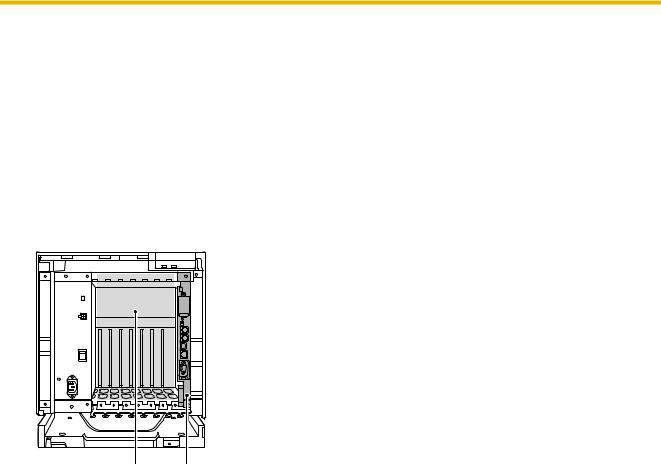
1.3.3 System Capacity
1.3.3 System Capacity
Maximum Optional Service Cards
There are 2 types of optional service cards for installation:
•Cards installed in the slots of the PBX
•Cards mounted on other optional service cards
Note
•Any card that exceeds the capacity of the PBX will be ignored.
•When the PBX starts up with an invalid configuration, some cards will be ignored.
Cards Installed in the Slots of the PBX
AB
A.Free Slots 1 to 7 (from the left)
B.DMPR Card Slot
The following number of optional service cards can be installed in the various slots of the PBX.
Card Type |
Maximum Number |
Installed in |
|
|
|
DMPR |
1 |
DMPR Card Slot |
|
|
|
Installation Manual |
23 |
|
|

1.3.3 System Capacity
Card Type |
Maximum Number |
Installed in |
|
|
|
|
|
Trunk Card |
Total 7*1 |
|
|
|
|
|
|
|
LCOT4 |
|
|
|
|
|
|
|
LCOT8 |
|
|
|
|
|
|
|
LCOT16 |
|
|
|
|
|
|
|
CLCOT8 |
7 |
|
|
|
|
|
|
DID8 |
|
|
|
|
|
|
|
|
|
|
|
E&M8 |
|
Free Slots 1 to 7 |
|
|
|
|
|
BRI4 |
|
|
|
|
|
|
|
|
|
|
|
BRI8 |
|
|
|
|
|
|
|
T1 |
|
|
|
|
|
|
|
E1 |
4 |
|
|
|
|
|
|
PRI23 |
|
|
|
|
|
|
|
|
|
|
|
PRI30 |
|
|
|
|
|
|
|
IP-GW4E |
4 |
|
|
|
|
|
|
IP-GW16 |
|
|
|
|
|
|
|
|
|
|
Extension Card |
Total 7 |
|
|
|
|
|
|
|
DLC8 |
|
|
|
|
|
|
|
DLC16 |
7 |
|
|
|
|
|
|
MCSLC16 |
|
|
|
|
|
|
|
|
|
|
|
IP-EXT16 |
|
Free Slots 1 to 7 |
|
|
|
|
|
MCSLC24 |
5 |
|
|
|
|
|
|
CSIF4 |
4 |
|
|
|
|
|
|
CSIF8 |
|
|
|
|
|
|
|
|
|
|
OPB3 |
4 |
|
|
|
|
|
|
CTI-LINK |
1 |
|
|
|
|
|
|
*1 |
When installing T1, E1, PRI30, or PRI23 cards, make sure that the number of these cards ´ 2 + the number of other cards (including |
|
|
|
IP-GW4E cards) does not exceed 8. |
24 Installation Manual

1.3.3 System Capacity
Cards Mounted on Other Optional Service Cards
The following number of optional service cards can be mounted on the specified other optional service cards.
Card Type |
Maximum Number |
Mounted on |
|
|
|
|
|
RMT |
1 |
DMPR Card |
|
|
|
|
|
CID/PAY8 |
14 |
LCOT8 Card/LCOT16 Card |
|
|
|||
CID8 |
|||
|
|
||
|
|
|
|
CLCOT8E |
7 |
CLCOT8 Card |
|
|
|
|
|
DPH4 |
4 |
|
|
|
|
|
|
DPH2 |
8 |
|
|
|
|
|
|
ECHO16 |
2*1 |
|
|
MSG4 |
|
OPB3 Card |
|
|
|
|
|
ESVM2 |
4 |
|
|
|
|
|
|
ESVM4 |
|
|
|
|
|
|
|
EIO4 |
4 |
|
|
|
|
|
*1 |
Only 1 ECHO16 card can be mounted on each OPB3 card. |
|
Installation Manual |
25 |
|
|

1.3.3 System Capacity
Maximum Terminal Equipment
The following number of items of terminal equipment can be supported by the PBX. For how to count the total number of items of equipment to be connected, refer to "Power Supply Unit Capacity".
|
Terminal Equipment Type |
Maximum Number |
|
|
|
Telephone |
176*1 |
|
|
|
|
|
SLT |
128 |
|
|
|
|
KX-DT300/KX-T7600 series DPT |
104 |
|
|
|
|
IP-PT |
112 |
|
|
|
DSS console |
8 |
|
|
|
|
CS |
26 |
|
|
|
|
High-density CS |
13 |
|
|
|
|
PS |
128 |
|
|
|
|
Voice Processing System (VPS) |
2 |
|
|
|
|
Doorphone |
16 |
|
|
|
|
Door Opener |
16 |
|
|
|
|
External Sensor |
16 |
|
|
|
|
External Relay |
16 |
|
|
|
|
*1 |
When the PBX is equipped with 104 DPTs (Digital XDP), 48 IP-PTs, and 24 SLTs. |
|
26 Installation Manual

1.3.3 System Capacity
Power Supply Unit Capacity
Calculate the load figure from the type and number of items of equipment to be connected.
Load Figure Calculation
|
|
Equipment Type |
|
|
Load Figure |
|
|
|
|
|
|
|
|
|
PT |
KX-DT300 series DPT/KX-DT300 series DSS |
|
1 |
||
|
|
console/KX-T7600 series DPT/KX-T7600 series |
|
|
||
|
|
DSS console |
|
|
|
|
|
|
|
|
|
|
|
|
|
IP-PT |
|
|
0 |
|
|
|
|
|
|
|
|
|
Trunk Card |
DID8 |
|
|
16 |
|
|
|
|
|
|
|
|
|
|
E&M8 |
|
|
8 |
|
|
|
|
|
|
|
|
|
|
Others |
|
|
0 |
|
|
|
|
|
|
|
|
|
Extension Card*1 |
MCSLC16 |
|
|
16 |
|
|
|
|
|
|
|
|
|
|
MCSLC24 |
|
|
24 |
|
|
|
|
|
|
|
|
|
CS (1 unit) |
|
|
|
|
4 |
|
|
|
|
|
|
|
|
PT-interface CS (1 unit) |
|
|
|
|
4 |
|
|
|
|
|
|
|
|
PT-interface CS (High-density) (1 unit) |
|
|
8 |
||
|
|
|
|
|
|
|
|
ISDN Extension |
|
|
|
|
2 |
|
|
|
|
|
|
|
|
VPS (1 port) |
|
|
|
|
1 |
|
|
|
|
|
|
|
*1 |
Only the extension cards that can support SLTs count for the load figures. |
|
|
|
||
|
|
|
|
|
|
|
Maximum Load Figure |
|
|
|
|
|
|
The pre-installed power supply unit (PSU) supports the following load figures. |
|
|
||||
|
|
|
|
|||
|
System Equipment |
|
Maximum Load Figure |
|||
|
|
|
|
|
|
|
|
Any Equipment |
|
|
|
104 |
|
|
|
|
|
|
||
|
Additional Load Capacity for a MCSLC16/ |
|
|
24 |
||
|
MCSLC24 Card |
|
|
|
|
|
|
|
|
|
|
|
|
|
Total |
|
|
|
128 |
|
|
|
|
|
|
|
|
In addition to any combination of equipment totalling a load figure of up to 104, one additional MCSLC16 card (load figure: 16) or one MCSLC24 card (load figure: 24) may also be added, for a total load figure of up to 128.
Installation Manual |
27 |
|
|

1.3.3 System Capacity
Calculation Example
Equipment Type |
Load Figure |
|
|
|
|
KX-DT300/KX-T7600 series DPT |
4 units |
4 |
|
|
|
MCSLC24 |
4 cards |
96 |
|
|
|
VPS |
8 ports |
8 |
|
|
|
Total |
|
108 |
|
|
|
28 Installation Manual

Section 2
Installation
This section describes the procedures to install the PBX. Detailed instructions for planning the installation site, installing the shelves and optional service cards, and cabling of peripheral equipment are provided. Further information on system expansion and peripheral equipment installation is included.
Installation Manual |
29 |
|
|

2.1.1 Before Installation
2.1 Before Installation
2.1.1 Before Installation
Please read the following notes concerning installation and connection before installing the PBX and terminal equipment.
Be sure to comply with all applicable laws, regulations, and guidelines.
Safety Installation Instructions
WARNING
When installing telephone wiring, basic safety precautions should always be followed to reduce the risk of fire, electric shock and injury to persons, including the following:
•Never install telephone wiring during a lightning storm.
•Never install telephone jacks in wet locations unless the jack is specifically designed for wet locations.
•Never touch uninsulated telephone wires or terminals unless the telephone line has been disconnected at the network interface.
•Use caution when installing or modifying telephone lines.
Installation Precautions
This set is made for wall mounting and should be installed in a location where it is accessible for inspections and maintenance.
To prevent malfunction, noise, or discolouration, follow the instructions below:
WARNING
Do not install the system in the following locations:
•Areas where shocks or vibrations are frequent or strong. Such activity may lead to the product falling over and causing injury, or may impair the product’s performance.
•Areas with high amounts of dust. High amounts of dust can lead to fire or electric shock, and impair the performance of the product.
CAUTION
Do not install the system in the following locations:
•In direct sunlight and hot, cold, or humid places. (Temperature range: 0 °C to 40 °C)
•Areas where sulfuric gases may be present, such as near thermal springs.
•Near devices that generate high frequencies, such as sewing machines or electric welders.
•Locations where other objects will obstruct the area around the PBX. Be especially careful to leave at least 20 cm of space above and 10 cm to the sides of the PBX for ventilation.
Notice
Do not install the system in the following locations:
•On or near computers, telexes, or other office equipment, as well as microwave ovens or air conditioners. (It is preferable not to install the system in the same room as the above equipment.)
•Within 1.8 m of radios and televisions. (Both the PBX and PTs should be at least 1.8 m away from such devices.)
Do not perform the following:
•Do not block the openings of the PBX.
•Do not stack up the optional service cards.
30 Installation Manual
